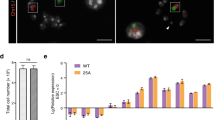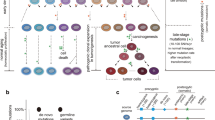Abstract
CHROMOSOME abnormalities similar to those known in man are now being found in mice1. Identification of the chromosome complement of these mice in cells from bone marrow2 or corneal epithelium3 involved the death of the animals. The advantage in identifying the chromosome complement of living mice is obvious, and the present communication describes techniques to achieve this in new-born and in adult mice, chiefly by the use of primary outgrowths of cells from pieces of tissue cultured in vitro.
This is a preview of subscription content, access via your institution
Access options
Subscribe to this journal
Receive 51 print issues and online access
$199.00 per year
only $3.90 per issue
Buy this article
- Purchase on Springer Link
- Instant access to full article PDF
Prices may be subject to local taxes which are calculated during checkout
Similar content being viewed by others
References
Welshons, W. J., and Russell, L. B., Proc. U.S. Nat. Acad. Sci., 45, 560 (1959). Cattanach, B. M., Genet. Res. Camb., 2, 156 (1961).
Ford, C. E., and Hamerton, J. L., Stain Tech., 31, 247 (1956).
Fechheimer, N. S., Nature, 188, 247 (1960).
Hsu, T. C., and Klatt, O., J. Nat. Cancer Inst., 21, 437 (1958). Rothfels, K. H., and Siminovitch, L., Stain Tech., 33, 73 (1958).
Author information
Authors and Affiliations
Rights and permissions
About this article
Cite this article
EDWARDS, R. Identification of the Chromosome Complements of New-born and Adult Living Mice. Nature 192, 1316–1317 (1961). https://doi.org/10.1038/1921316a0
Issue Date:
DOI: https://doi.org/10.1038/1921316a0
Comments
By submitting a comment you agree to abide by our Terms and Community Guidelines. If you find something abusive or that does not comply with our terms or guidelines please flag it as inappropriate.



